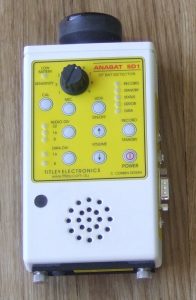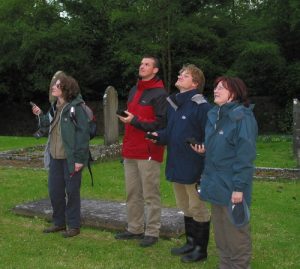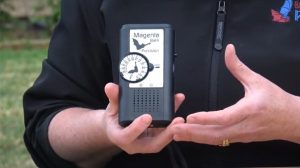The discovery of echolocation in the 1950s paved the way for the development of the first bat detectors.
Detectors are small hand-held instruments that pick up ultrasound (sounds at frequencies too high for the human ear to hear) and convert it into an audible sound.
A detector is an essential item of equipment for anyone developing an interest in bats and who wants to watch and identify them in the field.
There are several types of detectors, the cheapest can be bought for €80 upwards.
All bat detectors transform the sound made by bats into a sound that is audible to humans, or some detectors provide a graphic display of the sound made by
the bat. We have compiled a list of Bat Detector & Equipment Suppliers, some of whom offer discounts to BCIreland members, to assist you if you wish to buy one. Firstly though, read on for more information on how to make an informed decision on which one to purchase.
The cheapest detectors are heterodyne or tuneable, these allow the user to tune into a particular ultrasonic frequency. The resulting sound is a snap shot of the sound the bat makes as it passes. Identification is based on tonal quality, repetition rate and rhythm, not just on frequency. Surveyors who complete the All-Ireland Daubenton’s Waterways Survey use this kind of bat detector.
Other types of detectors are generally more expensive. Frequency division detectors divide the incoming frequencies, usually by 10, so a 60kHz sound becomes 6kHz for example. Frequency division detectors produce a sound in real time that can be used to identify the bat on the spot although sounds can also be recorded and analysed later. Recordings made by Frequency Division detectors are not normally a very high resolution so the calls can be harder to identify than for example, with time expansion detectors.

Time expansion detectors record the ultrasonic calls made by bats and play them back at a slow speed. Calls recorded from these detectors are usually analysed on another device such as a tablet or desktop computer. While this is more expensive and time consuming, the quality of data is usually quite high and identifications are generally more reliable. The Car-based Bat Monitoring Scheme is carried out using this type of detector.
Full spectrum detectors record the full spectrum of ultrasound continuously and often trigger when a bat comes into range of the microphone. The sound from these detectors is typically very high quality and can be viewed or listened-to in the field and/or recorded for later analysis. This kind of detector is currently being used by Bat Conservation Ireland in the Woodland Bat Monitoring Scheme.
Without training it is very difficult to distinguish bats in the field on the basis of sound from bat detectors. We recommend that you carefully consider what level of bat field surveying you would like to do before purchasing a bat detector.
Come along on some bat walks with us or your local bat group and/or volunteer for our monitoring surveys. We can lend you a bat detector for use during a monitoring scheme and this may help you decide what type you would prefer. Contact as many manufacturers or suppliers as possible to find out model specifications (see the list linked above). In addition if you plan to focus your efforts on a particular species it is important to check that the microphone of the detector has good sensitivity at the range of frequencies used by that species.
A number of ecology and bat detector suppliers offer discounts to members of Bat Conservation Ireland. Be sure to check whether such a discount may apply before making a purchase.
The Bat Conservation Trust of the UK also has some excellent resources for bat detector users including lists of suppliers.



